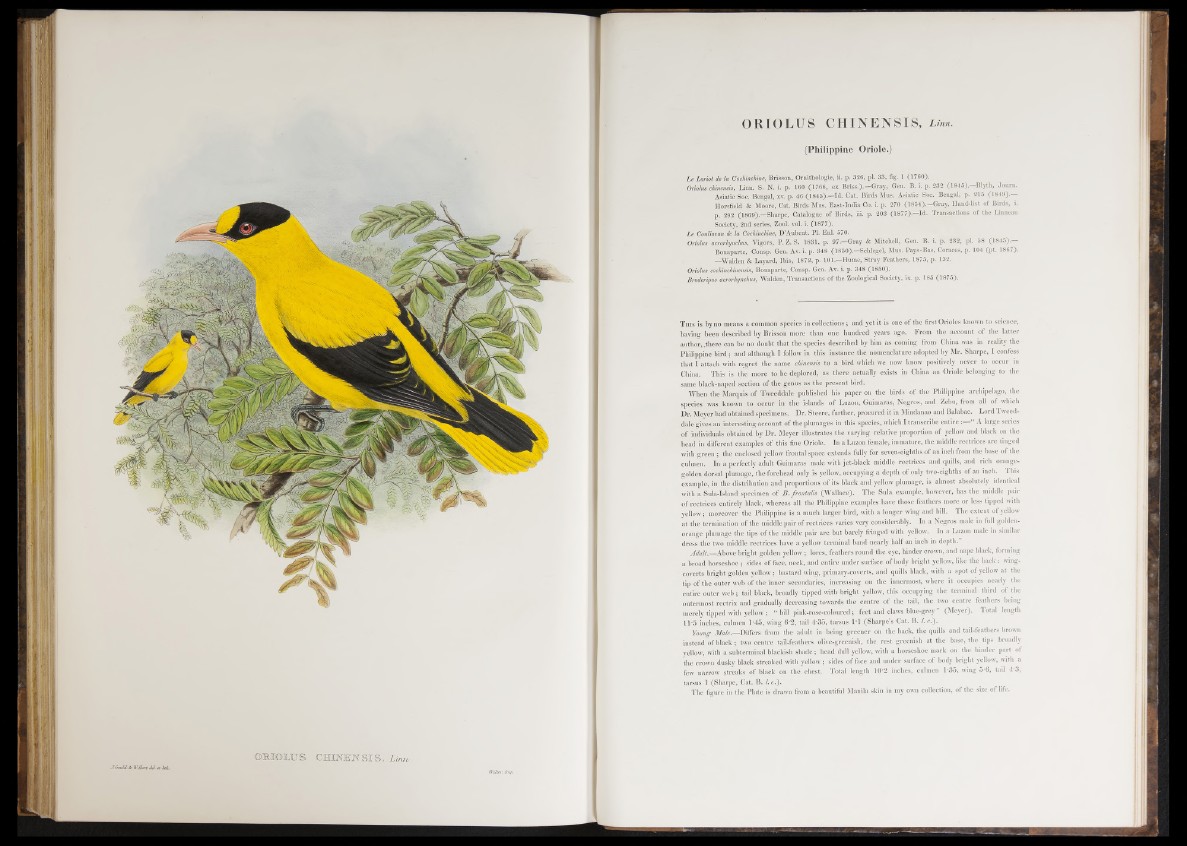
Q R I O E T J S C H I N E N S I S , , I i
O R I O L U S C H I N E N S I S , Linn.
(Philippine Oriole.)
Le Loriot de la Cochinchine, Brisson, Ornithologie, ii. p. 326, pl. 33, fig. 1 (1760).
Oriolus chinensis, Linn. S. N. i. p. 160 (1766, ex Briss.).—Gray, Gen. B. i. p. 232 (1845).—Blyth, Journ.
Asiatic Soc. Bengal, xv. p. 46 (1845).—Id. Cat. Birds Mus. Asiatic Soc. Bengal, p. 215 (1849).—g
Horsfield & Moore, Cat. Birds Mus. East-India Co. i. p. 270 (1854).—Gray, Hand-list of Birds, i.
p. 292 (1869).—Sharpe, Catalogue of Birds, iii. p. 203 (1877).—Id. Transactions of the Linnean
Society, 2nd series, Zool. vol. i. (1877).
Le Couliavan de la Cochinchine, D’Aubent. Pl. Enl. 570.
Oriolus acrorhynclms, Vigors, P. Z. S. 1831, p. 97.—Gray & Mitchell, Gen. B. i. p. 232, pl. 58 (1845).—
Bonaparte, Consp. Gen. Av. i. p. 348 (1850).—Schlegél, Mus. Pays-Bas, Coraces, p. 104 (pt. 1867).
—Walden & Layard, Ibis, 1872, p. 101.—Hume, Stray Feathers, 1875, p. 132.
Oriolus cochinchinensis, Bonaparte, Consp. Gen. Av. i. p. 348 (1850).
Broderipus acrorhynchus, Walden, Transactions of the Zoological Society, ix. p. 185 (1875).
T h is is by no means a common species in collections; and yet it is one o f the first Orioles known to science,
having been described by Brisson more than one hundred years ago. From the account of the latter
author, .there can be no doubt that the species described by him as coming from China was in reality the
Philippine b ird ; and although I follow in this instance the nomenclature adopted by Mr. Sharpe, I confess
that I attach with regret the name chinensis to a bird which we now know positively never to occur in
China. This is the more to be deplored, as there actually exists in China an Oriole belonging to the
same black-naped section of the genus as the present bird.
When the Marquis o f Tweeddale published his paper on the birds of the Philippine archipelago, the
species was known to occur in the islands of Luzon, Guimaras, Negros, and Zebu, from all of which
Dr. Meyer had obtained specimens. Dr. Steere, further, procured it in Mindanao and Balabac. Lord Tweeddale
gives an interesting account of the plumages in this species, which I transcribe e n tire : “ A large series
of individuals obtained by Dr. Meyer illustrates the varying relative proportion of yellow and black on the
head in different examples o f this fine Oriole. In a Luzon female, immature, the middle rectrices are tinged
with green ; the enclosed yellow frontal space extends fully for seven-eighths of an inch from the base of the
culinen. In a perfectly adult Guimaras male with jet-black middle rectrices and quills, and rich orange-
golden dorsal plumage, the forehead only is yellow, occupying a depth of only two-eighths of an inch. This
example, in the distribution and proportions of its black and yellow plumage, is almost absolutely identical
with a Sula-Island specimen o f B . frontalis (Wallace); The Sula example, however, has the middle pair
of rectrices entirely black, whereas all the Philippine examples have those feathers more or less tipped with
yellow; moreover the Philippine is a much larger bird, with a longer wing and bill. The extent of yellow
at the termination of the middle pair of rectrices varies very considerably. In a Negros male in full golden-
orange plumage the tips of the middle pair are but barely fringed with yellow. In a Luzon male in similar
dress the two middle rectrices have a yellow terminal band nearly half an inch in depth.
ddult.—Above bright golden yellow ; lores, feathers round the eye, hinder crown, and nape black, forming
a broad horseshoe ; sides of face, neck, and entire under surface of body bright yellow, like the b ack : wing-
coverts bright golden yellow; bastard wing, primary-coverts, and quills black, with a spot of yellow at the
tip of the outer weh of the inner secondaries, increasing on the innermost, where it occupies nearly the
entire outer web; tail black, broadly tipped with bright yellow, this occupying the terminal third of the
outermost rectrix and gradually decreasing towards the centre of the tail, the two centre feathers being
merely tipped with yellow; “ bill pink-rose-coloured; feet and claws blue-grey” (Meyer). Total length
11-5 inches, culmen 1-45, wing 6 2, tail 4-35, tarsus 1*1 (Sharpe’s Cat. B. /.<•.).
Young Male.—Differs from the adult in being greener on the back, the quills and tail-feathers brown
instead of b lack ; two centre tail-feathers olive-greenish, the rest greenish at the base, the tips broadly
yellow, with a subterminal blackish shade; head dull yellow, with a horseshoe mark on the hinder part of
the crown dusky black streaked with yellow; sides of face and under surface of body bright yellow, with a
few narrow §treaks of black on the chest. Total length 10-2 inches, culmen 1-35, wing 5-6, tail 4-3,
tarsus 1 (Sharpe, Cat. B. /. c.).
The figure in the Plate is drawn from a beautiful Manila skin in my own collection, o f the size of life.